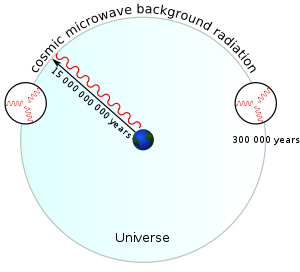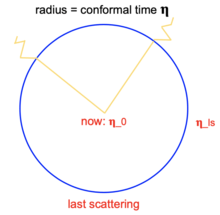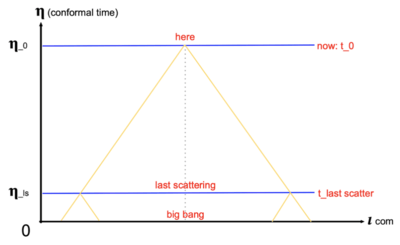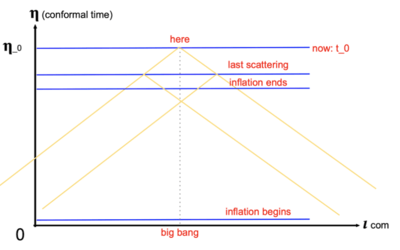Horizon problem
The horizon problem (also known as the homogeneity problem) is a cosmological fine-tuning problem within the Big Bang model of the universe. It arises due to the difficulty in explaining the observed homogeneity of causality disconnected regions of space in the absence of a mechanism that sets the same initial conditions everywhere. It was first pointed out by Wolfgang Rindler in 1956.[1]

The most commonly accepted solution is cosmic inflation. An explanation in terms of variable speed of light has also been proposed.
Background
Astronomical distances and particle horizons
The distances of observable objects in the night sky correspond to times in the past. We use the light-year (the distance light can travel in the time of one Earth year) to describe these cosmological distances. A galaxy measured at ten billion light-years appears to us as it was ten billion years ago, because the light has taken that long to travel to the observer. If one were to look at a galaxy ten billion light-years away in one direction and another in the opposite direction, the total distance between them is twenty billion light-years. This means that the light from the first has not yet reached the second because the universe is only about 13.8 billion years old. In a more general sense, there are portions of the universe that are visible to us, but invisible to each other, outside each other's respective particle horizons.
Causal information propagation
In accepted relativistic physical theories, no information can travel faster than the speed of light. In this context, "information" means "any sort of physical interaction". For instance, heat will naturally flow from a hotter area to a cooler one, and in physics terms, this is one example of information exchange. Given the example above, the two galaxies in question cannot have shared any sort of information; they are not in causal contact. In the absence of common initial conditions, one would expect, then, that their physical properties would be different, and more generally, that the universe as a whole would have varying properties in causally disconnected regions.
Horizon problem
Contrary to this expectation, the observations of the cosmic microwave background (CMB) and galaxy surveys show that the observable universe is nearly isotropic, which, through the Copernican principle, also implies homogeneity.[2] CMB sky surveys show that the temperatures of the CMB are coordinated to a level of where is the difference between the observed temperature in a region of the sky and the average temperature of the sky . This coordination implies that the entire sky, and thus the entire observable universe, must have been causally connected long enough for the universe to come into thermal equilibrium.
According to the Big Bang model, as the density of the expanding universe dropped, it eventually reached a temperature where photons fell out of thermal equilibrium with matter; they decoupled from the electron-proton plasma and began free-streaming across the universe. This moment in time is referred to as the epoch of Recombination, when electrons and protons became bound to form electrically neutral hydrogen; without free electrons to scatter the photons, the photons began free-streaming. They are now observed as the CMB. This epoch is observed through the CMB. Since we observe the CMB as a background to objects at a smaller redshift, we describe this epoch as the transition of the universe from opaque to transparent. The CMB physically describes the ‘surface of last scattering’ as it appears to us as a surface, or a background, as shown in the figure below.
Note we use conformal time in the following diagrams. Conformal time describes the amount of time it would take a photon to travel from the location of the observer to the farthest observable distance (if the universe stopped expanding right now).

The decoupling, or the last scattering, is thought to have occurred about 300,000 years after the Big Bang, or at a redshift of about . We can determine both the approximate angular diameter of the universe and the physical size of the particle horizon that had existed at this time.
The angular diameter distance, in terms of redshift z, is described by . If we assume a flat cosmology then,
The epoch of recombination occurred during a matter dominated era of the universe, so we can approximate H(z) as Putting it together, we see that the angular diameter distance, or the size of the observable universe, for a redshift is,
.
Since , we can approximate ,
The particle horizon describes the maximum distance light particles could have traveled to the observer given the age of the universe. We can determine the comoving distance for the age of the universe at the time of recombination using r(z) from earlier,

To get the physical size of the particle horizon ,
We would expect any region of the CMB within 2 degrees of angular separation to have been in casual contact, but at any scale larger than 2° there should have been no exchange of information.
CMB regions that are separated by more than 2° lie outside one another’s particle horizons and are causally disconnected. The horizon problem describes the fact that we see isotropy in the CMB temperature across the entire sky, despite the entire sky not being in causal contact to establish thermal equilibrium. Refer to the timespace diagram to the right for a visualization of this problem.
If the universe started with even slightly different temperatures in different places, the CMB should not be isotropic unless there is a mechanism that evens out the temperature by the time of decoupling. In reality, the CMB has the same temperature in the entire sky, 2.726 ± 0.001 K.[3]
Inflationary model

The theory of cosmic inflation has attempted to address the problem by positing a 10−32-second period of exponential expansion in the first second of the history of the universe due to a scalar field interaction.[4] According to the inflationary model, the universe increased in size by a factor of more than 1022, from a small and causally connected region in near equilibrium.[5] Inflation then expanded the universe rapidly, isolating nearby regions of spacetime by growing them beyond the limits of causal contact, effectively "locking in" the uniformity at large distances. Essentially, the inflationary model suggests that the universe was entirely in causal contact in the very early universe. Inflation then expands this universe by approximately 60 e-foldings (the scale factor a increases by e60). We observe the CMB after inflation has occurred at a very large scale. It maintained thermal equilibrium to this large size because of the rapid expansion from inflation.
One consequence of cosmic inflation is that the anistropies in the Big Bang due to quantum fluctuations are reduced but not entirely eliminated. Differences in the temperature of the cosmic background are smoothed by cosmic inflation, but they still exist. The theory predicts a spectrum for the anisotropies in the microwave background which is mostly consistent with observations from WMAP and COBE.[6]
Variable-speed-of-light theories
A varying-speed-of-light (VSL) cosmological model has been proposed independently by Jean-Pierre Petit in 1988,[7][8][9][10] John Moffat in 1992,[11] and the two-man team of Andreas Albrecht and João Magueijo in 1998[12][13][14][15][16][17] to explain the horizon problem of cosmology and propose an alternative to cosmic inflation. In the VSL models, the fundamental constant c, denoting the speed of light in vacuum, is greater in the early universe than its present value, effectively increasing the particle horizon at the time of decoupling sufficiently to account for the observed isotropy of the CMB.
Petit model
In Petit's VSL model, the variation of the speed of light c accompanies the joint variations of all physical constants combined to space and time scale factors changes, so that all equations and measurements of these constants remain unchanged through the evolution of the universe. The Einstein field equations remain invariant through convenient joint variations of c and G in the Einstein gravitational constant. According to this model, the cosmological horizon grows like R, the space scale, which ensures the homogeneity of the primeval universe, which fits the observational data. Late-model restricts the variation of constants to the higher energy density of the early universe, at the very beginning of the radiation-dominated era where spacetime is identified to space-entropy with a metric conformally flat.[18][19]
See also
External links
For a simplified summary and overview of different horizons in cosmology, see Different Horizons in Cosmology
References
- Carrigan, Richard A.; Trower, W. Peter (1983). Magnetic Monopoles. doi:10.1007/978-1-4615-7370-8. ISBN 978-1-4615-7372-2.
- http://ned.ipac.caltech.edu/level5/Peacock/Peacock3_1.html
- Fixsen, D. J. (2009). "The Temperature of the Cosmic Microwave Background". The Astrophysical Journal. 707 (2): 916–920. arXiv:0911.1955. Bibcode:2009ApJ...707..916F. doi:10.1088/0004-637X/707/2/916.
- An Exposition on Inflationary Cosmology, Gary Scott Watson, Dept. of Physics, Brown University
- Remmen, Grant N.; Carroll, Sean M. (2014). "How many e-folds should we expect from high-scale inflation?". Physical Review D. 90 (6): 063517. arXiv:1405.5538. Bibcode:2014PhRvD..90f3517R. doi:10.1103/PhysRevD.90.063517. ISSN 1550-7998.
- Starkman, Glenn D. and Dominic J. Schwarz; Scientific American (subscription required)
- J.P. Petit (1988). "An interpretation of cosmological model with variable light velocity" (PDF). Mod. Phys. Lett. A. 3 (16): 1527–1532. Bibcode:1988MPLA....3.1527P. CiteSeerX 10.1.1.692.9603. doi:10.1142/S0217732388001823. Archived from the original (PDF) on 2015-02-03. Retrieved 2014-12-24.
- J.P. Petit (1988). "Cosmological model with variable light velocity: the interpretation of red shifts" (PDF). Mod. Phys. Lett. A. 3 (18): 1733–1744. Bibcode:1988MPLA....3.1733P. CiteSeerX 10.1.1.692.9067. doi:10.1142/S0217732388002099. Archived from the original (PDF) on 2014-07-18. Retrieved 2014-12-24.
- J.P. Petit; M. Viton (1989). "Gauge cosmological model with variable light velocity. Comparizon with QSO observational data" (PDF). Mod. Phys. Lett. A. 4 (23): 2201–2210. Bibcode:1989MPLA....4.2201P. doi:10.1142/S0217732389002471. Archived from the original (PDF) on 2015-02-04. Retrieved 2014-12-24.
- P. Midy; J.P. Petit (1989). "Scale invariant cosmology" (PDF). Int. J. Mod. Phys. D (8): 271–280. Archived from the original (PDF) on 2014-07-17. Retrieved 2014-12-24.
- J. Moffat (1993). "Superluminary Universe: A Possible Solution to the Initial Value Problem in Cosmology". Int. J. Mod. Phys. D. 2 (3): 351–366. arXiv:gr-qc/9211020. Bibcode:1993IJMPD...2..351M. doi:10.1142/S0218271893000246.
- J.D. Barrow (1998). "Cosmologies with varying light-speed". Physical Review D. 59 (4): 043515. arXiv:astro-ph/9811022. Bibcode:1999PhRvD..59d3515B. doi:10.1103/PhysRevD.59.043515.
- A. Albrecht; J. Magueijo (1999). "A time varying speed of light as a solution to cosmological puzzles". Phys. Rev. D59 (4): 043516. arXiv:astro-ph/9811018. Bibcode:1999PhRvD..59d3516A. doi:10.1103/PhysRevD.59.043516.
- J. Magueijo (2000). "Covariant and locally Lorentz-invariant varying speed of light theories". Phys. Rev. D62 (10): 103521. arXiv:gr-qc/0007036. Bibcode:2000PhRvD..62j3521M. doi:10.1103/PhysRevD.62.103521.
- J. Magueijo (2001). "Stars and black holes in varying speed of light theories". Phys. Rev. D63 (4): 043502. arXiv:astro-ph/0010591. Bibcode:2001PhRvD..63d3502M. doi:10.1103/PhysRevD.63.043502.
- J. Magueijo (2003). "New varying speed of light theories". Rep. Prog. Phys. 66 (11): 2025–2068. arXiv:astro-ph/0305457. Bibcode:2003RPPh...66.2025M. doi:10.1088/0034-4885/66/11/R04.
- J. Magueijo (2003). Faster Than the Speed of Light: The Story of a Scientific Speculation. Massachusetts: Perseus Books Group. ISBN 978-0-7382-0525-0.
- J.P. Petit; P. Midy; F. Landsheat (2001). "Twin matter against dark matter" (PDF). "Where is the matter?" (See sections 14 and 15 pp. 21–26). Int. Conf. on Astr. & Cosm. Archived from the original (PDF) on 2015-02-04. Retrieved 2014-12-24.
- J.P. Petit; G. d'Agostini (2007). "Bigravity: a bimetric model of the Universe with variable constants, including VSL (variable speed of light)". arXiv:0803.1362 [physics.gen-ph].